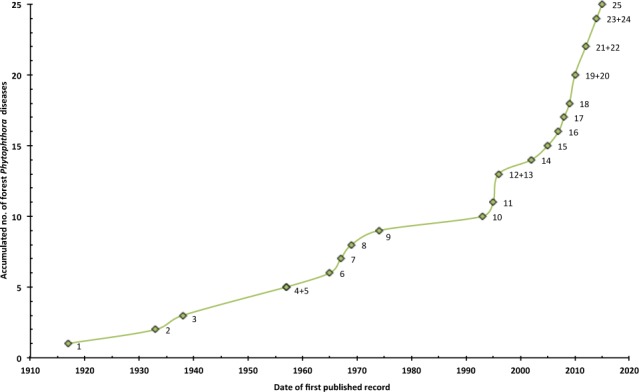Fig. 1.

Accumulated number of important Phytophthora declines and diebacks of forests and natural ecosystems over time; 1 = ink disease of Castanea sativa in Europe (observation of first typical symptoms in 1838); 2 = ink disease of Castanea dentata in the USA (observation of first typical symptoms in 1824); 3 = decline of Fagus sylvatica in the UK; 4 = littleleaf disease of pines in the USA; 5 = decline and mortality of Chamaecyparis lawsoniana in the Pacific Northwest; 6 = jarrah dieback in Western Australia (WA; observation of first typical symptoms in the 1920s); 7 = ink disease of C. crenata and chestnut hybrids in Korea; 8 = eucalypt dieback in Victoria (observation of first typical symptoms in 1935); 9 = kauri dieback in New Zealand; 10 = Mediterranean oak decline; 11 = Alnus mortality in Europe; 12 = temperate European oak decline; 13 = decline of F. sylvatica in mainland Europe; 14 = Sudden Oak Death in California and Oregon; 15 = mortality of Austrocedrus chilensis in Argentina (observation of first typical symptoms in 1948); 16 = oak decline in the Eastern USA; 17 = needle cast and defoliation of Pinus radiata in Chile; 18 = dieback of Eucalyptus gomphocephala in WA; 19 = dieback of E. rudis in WA; 20 = Sudden Larch Death in the UK; 21 = dieback of Nothofagus spp. in the UK; 22 = mortality of Juniperus communis in the UK; 23 = red needle cast of P. radiata in New Zealand; 24 = leaf and twig blight of Ilex aqufolium in Corsica and Sardinia; 25 = dieback of Mediterranean maquis vegetation.
